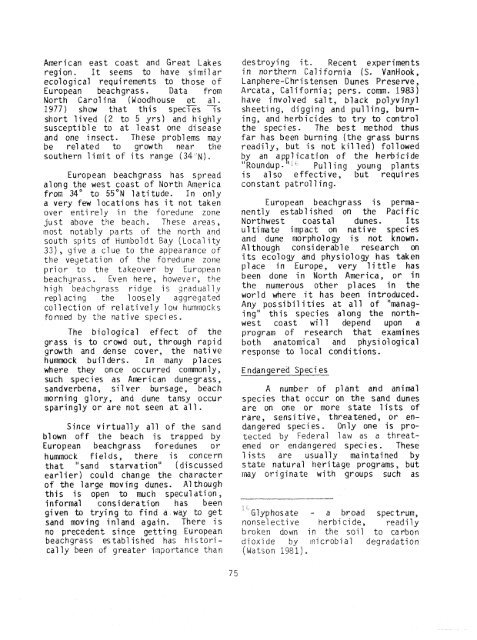The ecology of Pacific Northwest coastal sand dunes
The ecology of Pacific Northwest coastal sand dunes
The ecology of Pacific Northwest coastal sand dunes
Create successful ePaper yourself
Turn your PDF publications into a flip-book with our unique Google optimized e-Paper software.
American east coast and Great Lakes<br />
region. It seems ts~ have similar<br />
ecological requi rements to those <strong>of</strong><br />
European beachgrass. Data from<br />
North Carol ina ( Woodhouse et a1 .<br />
---(P<br />
1977) show that this specEs 1s<br />
short lived (2 to 5 yrs) and higtlly<br />
susceptible to at least one disease<br />
and one insect. <strong>The</strong>se problems may<br />
be related to growth near the<br />
southern 1 imit <strong>of</strong> its range (34 N).<br />
European beachgrass has spread<br />
along the west coast <strong>of</strong> North America<br />
from 34" to 55"N latitude. In only<br />
a very few locations has it not taken<br />
over enti rely in the foredune zone<br />
just above tile beach. <strong>The</strong>se areas,<br />
rnost notably parts <strong>of</strong> the north and<br />
south spits <strong>of</strong> tiurnboldt Bay (Local ity<br />
33), give a clue to the api~earance <strong>of</strong><br />
the vegetation <strong>of</strong> the foredune aorw<br />
prior to the takeover by European<br />
beachyrass . Even here, howevc I*, the<br />
high bedchgrass rid ye is qradual ly<br />
rep1 aci ng the 1 oosely aggregated<br />
collection <strong>of</strong> relatively 7a.r hui~~rriocks<br />
fo rrned by t!~e na 2; i ve speci es .<br />
<strong>The</strong> biological effect <strong>of</strong> the<br />
grass is to crowd out, through rapid<br />
growth and dense cover, the native<br />
hummock builders. In many places<br />
where they once occurred commonly,<br />
such species as American dunegrass,<br />
<strong>sand</strong>verbena, si 1 ver bursage, beach<br />
morning glory, and dune tansy occur<br />
sparingly or are not seen at a1 1.<br />
Since virtually a71 <strong>of</strong> the <strong>sand</strong><br />
blown <strong>of</strong>f the beach is trapped by<br />
European beachgrass fore<strong>dunes</strong> or<br />
hummock fields, there is concern<br />
that "<strong>sand</strong> starvation" (discussed<br />
earlier) could change the character<br />
<strong>of</strong> the 'large moving <strong>dunes</strong>. Although<br />
this is open to much specuf ation,<br />
informal consideration has been<br />
gi wen to trying to find a way to get<br />
<strong>sand</strong> moving inland again. <strong>The</strong>re is<br />
na precedent since getting European<br />
beachgrass es tab1 isked has his tori -<br />
eally been <strong>of</strong> greater importance than<br />
destroying it, Recent experiments<br />
in northern Cal ifornia IS. VanHook,<br />
Lanphere-Chris tensen Dunes Preserve,<br />
Arcata, California; pers, corn. 19833<br />
have involved sa't t, black polyvinyl<br />
sheeting, digging and pulling, burning,<br />
and herbicides to try .to control<br />
the species. <strong>The</strong> best method thus<br />
far has been burning (the grass burns<br />
readily, but is not killed) followed<br />
by an application <strong>of</strong> the herbicide<br />
'"~oundup - Pulling young plants<br />
is also effective, but requires<br />
constant patrol 1 ing.<br />
European beachgrass is permanently<br />
established on the <strong>Pacific</strong><br />
<strong>Northwest</strong> coas ta1 <strong>dunes</strong>. Its<br />
ultimate impact on nati we species<br />
and dune morphologiy is not known.<br />
Al though con si derabl e research on<br />
its <strong>ecology</strong> and physiology has taken<br />
place in Europe, very little has<br />
been done in North America, or in<br />
the numerous other places in the<br />
world where it has been introduced.<br />
Any possibil i ties at all <strong>of</strong> "managing"<br />
this species along the northwest<br />
coast will depend upon a<br />
program <strong>of</strong> research that examines<br />
both anatomical and physi 01 ogical<br />
response to local conditions.<br />
Endangered Species<br />
A number <strong>of</strong> plant and animal<br />
species that occur on the <strong>sand</strong> <strong>dunes</strong><br />
are on one or more state lists <strong>of</strong><br />
rare, sensitive, threatened, or endangered<br />
species. Only one is protected<br />
by Federal law as a threatened<br />
or endangered species. <strong>The</strong>se<br />
1 ists are usually maintained by<br />
state natural heritage programs, but<br />
rmy originate with gruups such as<br />
Glyphssate - a broad spectrum,<br />
nonselective herbicide, readily<br />
broken down in the soil to carbon<br />
dioxide by r~ticrobial degradation<br />
(Watson 1981).

















